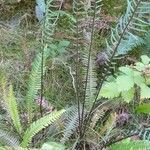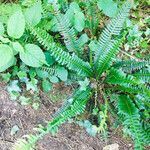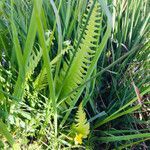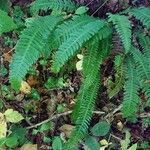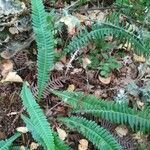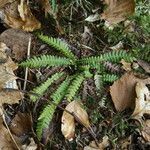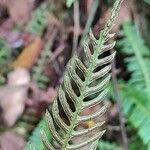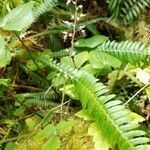Stems slender, short-creeping or ascending, not climbing. Leaves dimorphic, cespitose, erect or spreading, fertile leaves more erect and longer than sterile leaves. Petioles of fertile leaves reddish brown to purple-black, 15-60 cm, coarsely scaly proximally. Petioles of sterile leaves reddish brown, 2-30 cm, coarsely scaly proximally. Fertile blades erect, narrowly rhombic, 1-pinnate, without conform terminal pinna, 25-65 × 3-15 cm, glabrous. Sterile blades spreading, narrowly oblanceolate to linear-lanceolate, pinnatifid to apex and so without conform terminal pinna, 20-75 × 3-14 cm, tapering at base, glabrous. Rachises of fertile and sterile leaves with indument of filiform, spreading scales abaxially. Fertile pinnae not articulate to rachis, sessile, decurrent and surcurrent to rachis; larger pinnae slightly curved, linear, 25-32 × 1.5-2 mm; margins entire, slightly to moderately revolute; costae with indument of a few small scales abaxially, often concealed by sori. Sterile pinnae closely spaced, not articulate to rachis, base fully adnate; larger pinnae curved, linear to oblong-linear or barely wider beyond middle, 15-35 × 3.5-5 mm; margins entire. 2 n = 68.
More
A fern with year round foliage. It grows 30-45 cm high and 45-60 cm wide. It grows in tufts. The sterile fronds form a large flat rosette. They grow almost flat on the ground. They are 15-20 cm long and 3.5 cm across. They have up to 60 pairs of closely set leaflets. The fertile fronds stand very upright from the centre of this. Frond shape can vary. The fertile fronds are 75 cm long.
Woods, heaths, moors, mountain grassland and on rocks; at elevations to 1,200 metres. Wet coniferous woods and swamps, primarily along the coast and in coastal mountain ranges; at elevations to 1,400 metres in western N. America.
More
It is a temperate plant. It is frost hardy. It grows in wet acidic soils and peat bogs. The soils need to be lime free. It suits hardiness zones 5-9.
